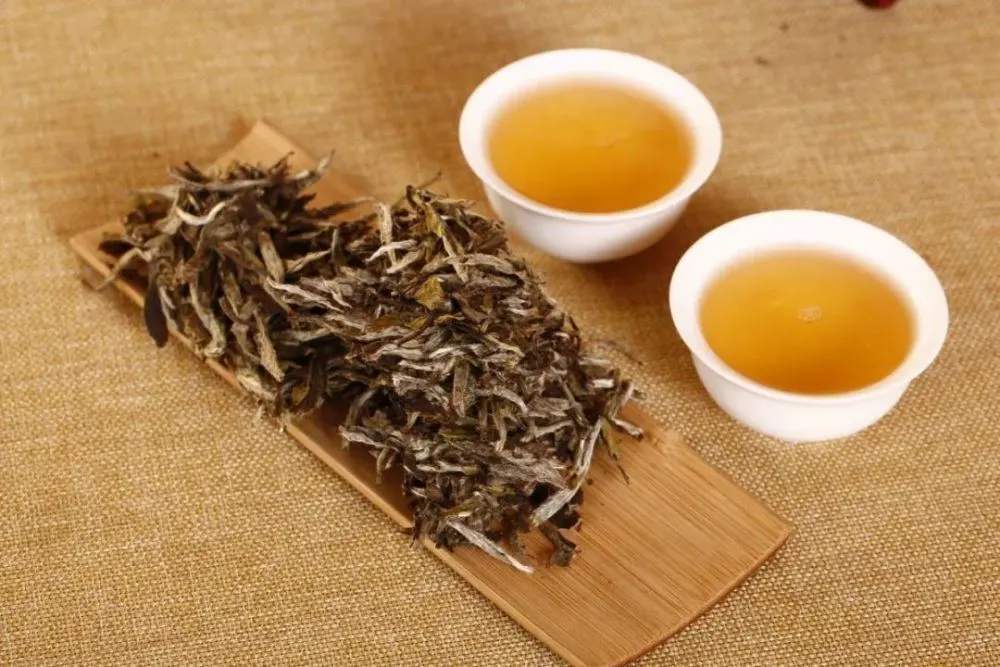White tea, a lightly-fermented tea, is a traditional famous tea produced by Chinese tea farmers. It is one of six major types of tea in China. After the tea leaves are picked, they are only dried in the sun without the process of fixation or rolling. The tea products are mainly buds covered with white fuzz. The main producing areas of white tea are Fuding in Fujian and Jinggu in Yunnan. White tea is a special treasure in Chinese tea culture.
White tea can be divided into 5 types based on different tea tree varieties and raw material (fresh leaf) picking standards: White Tip Silver Needle, White Peony, Gong Mei, Shou Mei, and New White Tea.

White Tip Silver Needle is also known as White Tip or Silver Needle. It was firstly made in Fuding, Fujian in 1796. The needle-shaped tea products are covered with thick white fuzz, hence the name. White tea has a very mellow and delicate flavor. With super quality, it is honored “the beauty” and “the king of tea.” Straight cylindrical transparent glass cups are usually used to brew White Tip Silver Needle, because tea drinkers can appreciate the tea’s appearance and color from all angles. The White Tip Silver Needle teas are mainly sold to Southeast Asia, Germany and the United States. In the early days, Europeans added some White Tip Silver Needle teas to the black tea. The purpose of doing so is to show the preciousness of White Tip Silver Needle.

White peony, also known as Bai Mudan, was firstly made in Fujian in 1922. The brewed tea leaves have a peony-like appearance, hence the name. The tea is made from unopened tea buds through such key processes as withering and baking. The liquid has a sweet and mild taste and is golden in color. It is rich in plant’s natural antioxidants, because artisans carry out minimal processing. It can be stored quite well at a normal temperature.

It is the highest yield variety in white tea. It is grown mainly in Fujian Province and Guangxi Province in China. The liquid is slightly darker in color and stronger in taste. It is featured by fat buds and tender leaves. With a few broken leaves, it smells fragrant.
It is grown mainly in Fujian Province and Guangxi Province in China. It is made from upper tea leaves and tips that are naturally withered, so that the liquid has a stronger flavor. Tea enthusiasts must be delighted by its smooth, mellow, and sweet flavor. Good mineral water is usually used to brew the tea to keep its sweetness and aroma.

New white tea, a special product of Fujian, was created in 1968. It is mainly produced in such areas as Fuding, Zhenghe, Songxi, and Jianyang. It has the effects of anti-cancer and heatstroke prevention. It has been exported to many countries and regions such as the EU, Southeast Asian countries and Japan.
The medicinal properties of white tea are highly praised by the health experts. It is effective for clearing heat, moistening the lungs, lowering the blood lipids, and eliminating fatigue. White tea has a unique health function, especially for the symptoms of physical discomfort and digestive dysfunction caused by excessive tobacco and alcohol.
White tea is effective for preventing cancer, heatstroke, toothache, and so on. White tea can be used as an antipyretic medicine for children with measles, and its antipyretic effect is better than antibiotics. It is widely regarded as a good medicine for the treatment of measles patients in North China and Fujian.
In addition to the nutritional components of other teas, white tea also contains active enzymes necessary for the human body. Drinking white tea for a long time can significantly increase lipoprotein lipase activity in the body, promote fat catabolism, and effectively control insulin secretion. It can also help delay the intestinal absorption of grape powder, break down excess sugar in the blood, and promote blood sugar balance. White tea is rich in amino acids and effective for reducing fever, eliminating heat and removing toxins.
The longer the white tea is stored, the higher its medicinal value is. White tea also contains a rich source of vitamin A, which can be quickly converted into vitamin A after being absorbed by the body. Vitamin A helps synthesize rhodopsin, make the eye see things more clearly in dark light, and prevent night blindness and dry eye disease.
White tea is rich in dihydromyricetin and other natural substances to protect the liver. Dihydromyricetin works quickly and has a long-lasting effect. It is a good product for protecting the liver.
1. The amount of water used should be controlled. Generally, 150 ml of water can be used to brew 3-5 g of white tea leaves.
2. The temperature of water should be controlled at 90-100°C.
3. The first brewing lasts about 5 minutes. You may drink the liquid after filtration. The second brewing takes only 3 minutes. Generally, the tea leaves can be brewed 4-5 times.
